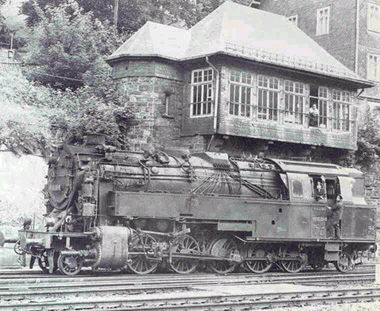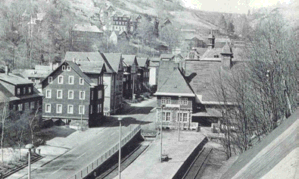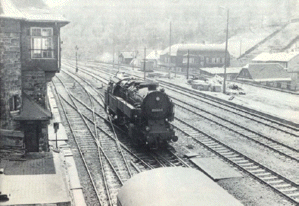
Photos on this page by jw/W.I. Published in Miba, issues 7/81 and 8/81
Lauscha
the glasstown with a switchback.

The modest town of Lauscha is mostly known for glass and where the German Santa Claus lives, but also hostes a interesting yard, with interesting equipment. The steep grades where the reason for the Deutsche Reichbahn to use The husky 2-10-2 tank engines of Br 95. The topogaphic location is testified by the locations of few of the stations, Probstzella 343 meteres over the sea level, Ernstthal 769 meters, Lauscha 620 meters and Sonneberg 386 meters. Ernstthal is located only 6.5 kilometers from Lauscha. Lauscha itself, is located in a narrow valley. So only solution for the line was a switchback and loop and a steep grade to Ernstthal. The line Sonneberg - Lauscha was opened in 1886, as the work preceided on the line from Probstzella which was opened in 1913 and the station was from now on a switchback. The orginal depot is used as freight terminal and a new depot was built in 1913.
Lauscha in model in magazines.
In German magazines there has been two articles on modelling Lauscha. One in Alba Verlags serie of small books of Alba-Modellbahn-Praxis. In their Band 2, Modellbahn-Anlagenplanung They ran an article on modelling the line from Sonneberg to Lauscha. The yards was redused and the yard of Lichte turned 180 degrees to fit the the layout. But the attention of the the plan was to capture the area of Thüringen Wald. Those of you with limited space, still wanting to model Lauscha, can base their layout on this.
The MIBA magazine ran theirs was published in issues issues 7/81 and 8/81. The features was based on only on Lauscha. And it featured a more accurate version of the yards and the various tracks.
Miba has included an article in their MIBA Planungshilfen 88 Gleisplan-Vorschläge with other trackplanning articles. Right now, I don't know if the piece on Lauscha is bases on same article as the one that is the bulk of this web site. Eisenbahn Journal has included a pice on Lauscha in their exellent series of magasin line of "Super Anlagen" based on home layout. See more details here.
The Br 95.
One of the last prussians.

The final of the prussian tankengine designs were the largest. The heavy 2 -10 -2 twin cylinder engines were to classified as T 20 class and inclueding the final developement of the Prussian design such as Belpair boiler and Barren frame, with the weight of totally 95.3 tons they where the heaviest tankengines before the Br85 engines where delivered.
But when 10 first of the class were to be delivered in 1922, all provincial railroad companies were to be reformed in to a one national railroad company, The Deutsche Reichsbahn. The DRG classified the engines as Br 77 class receiving the numbers 77 001 - 77 010. But in next year the engines were to be reclassified in to Br 95 class. During 1923 and 1924 DRG received 35 additional engines of the class delivered. The engines were to be used as helpers and to used on lines where previously gog-track were used. The trialruns were held on Halberstadt - Blankerburger line, on the grades of Geislinger Steige. And former goq-lies of Honau - Lichtenstein with grades of 10%! and Klosterreichbach - Freudenstadt with grades of 5%. The engines were used in Thüringer Wald area, as a helpers on Geislinger Steige, and Neuenmarkt - Wirsberg and Laufach - Helgenbrücken.
After WWII. 14 of the engines became inventory of Deutsche Bundesbahn (95 001 -003,006-008, 011 -013, 026, 031, 033 - 035) and the last of the engines were withdrawn on DB in 1958. The remaining 31 were in service on DR (DDR). The DR engines were based in Probstzella but some of them were based in Blankenburg/Harz. 24 of the engines were modified as oilfired and the bunkers were modified to store oil. In 1978/79 still a number of 20 engines were still based in Probstzella, which since Rügeland line was electrified was the sole depot using the class. But when the Rumanian built diesels of 119 class were based in Probstzella the 95 class was withdrawn from service. The 95 027 is preserved as a part of the historical engine fleet by DBAG.